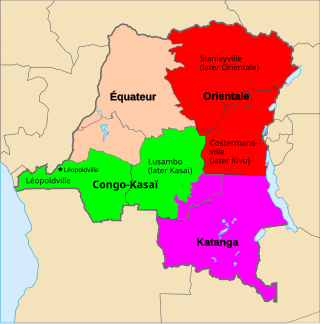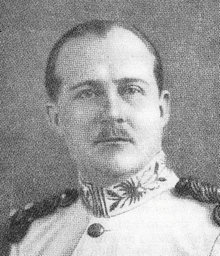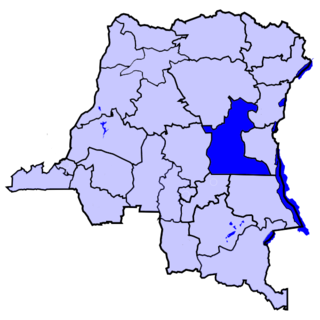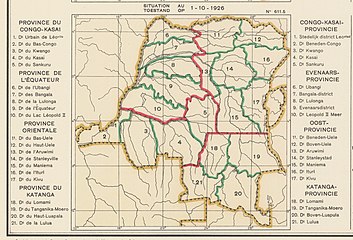
Orientale Province is one of the former provinces of the Democratic Republic of the Congo and its predecessors the Congo Free State and the Belgian Congo. It went through a series of boundary changes between 1898 and 2015, when it was divided into smaller units.

Ituri District, later Kibali-Ituri District, was a district of the Belgian Congo and the Democratic Republic of the Congo. It roughly corresponded in area to the present Ituri Province.

Haut-Uele District was a district of the Belgian Congo and the Democratic Republic of the Congo. It was formed from part of Uele District in 1912. It roughly corresponded in area to the present Haut-Uélé province.

Bas-Uele District was a district of the Belgian Congo and the Democratic Republic of the Congo. It was formed from part of Uele District in 1912 and was later merged into Uele District, then split out again. There were various boundary changes. It roughly corresponded in area to the present Bas-Uélé province.

Kivu Province was a province in the Belgian Congo, originally called Costermansville Province, that was formed in 1933 from part of the old Orientale Province. The Republic of the Congo (Léopoldville) became independent in 1960, and between 1962 and 1966 the province was temporarily broken into the provinces of Maniema, North Kivu and South Kivu. In 1988 it was again broken into these provinces.

Alfred Alphonse Moeller de Laddersous was a Belgian lawyer, colonial administrator and businessman. He served as governor of the Orientale Province in the Belgian Congo from 1926 to 1933.

Maniema District was a district of the Belgian Congo and the Democratic Republic of the Congo. It roughly corresponded in area to the present Maniema province.

The Districts of the Belgian Congo were the primary administrative divisions when Belgium annexed the Congo Free State in 1908, each administered by a district commissioner. In 1914 they were distributed among four large provinces, with some boundary changes. In 1933 the provinces were restructured into six, again with boundary changes. The number of districts fluctuated between 12 and 26 through splits and consolidations, first rising, then falling, then rising again.

Stanleyville District was a district of the Belgian Congo and Democratic Republic of the Congo. It went through various changes in extent. Between 1933 and 1963 it had roughly the same extent as the current Tshopo province.
Lowa District was a district of the Belgian Congo. It was formed from part of Stanleyville District in 1914, and had been absorbed by Maniema District and Kivu District by 1926.
Uele District was a district of the Congo Free State and the Belgian Congo. It roughly corresponded to the current provinces of Bas-Uélé and Haut-Uélé.
Tanganika-Moero District was a district of the Belgian Congo from 1912 to 1933, when it was dissolved. It roughly corresponded to the present Tanganyika Province and the northern part of Haut-Katanga Province.

Tanganika District was a district of the pre-2015 Katanga Province in the Democratic Republic of the Congo. The district dates back to the days of the Belgian Congo. At its greatest extent it roughly corresponded to the present Tanganyika Province, with a small portion in the southwest now in Haut-Lomami Province.

Sud-Kivu District was a district of the Belgian Congo and the Democratic Republic of the Congo. It roughly corresponded in area to the present South Kivu province.

Nord-Kivu District was a district of the Belgian Congo and the Democratic Republic of the Congo. It roughly corresponded in area to the present North Kivu province.
Bomane is a village on the Aruwimi River in the Tshopo province of the Democratic Republic of the Congo.
Umangi is a village on the right bank of the Congo River downstream from Lisala in the Mongala province of the Democratic Republic of the Congo.

Upoto was a village on the right bank of the Congo River, now a district of Lisala in the Mongala province of the Democratic Republic of the Congo.
The Gada River is a left tributary of the Uele River, which it joins downstream from Niangara in the Haut-Uélé province of the Democratic Republic of the Congo.
Amadi is a town in the Bas-Uélé province of the Democratic Republic of the Congo (DRC).

















